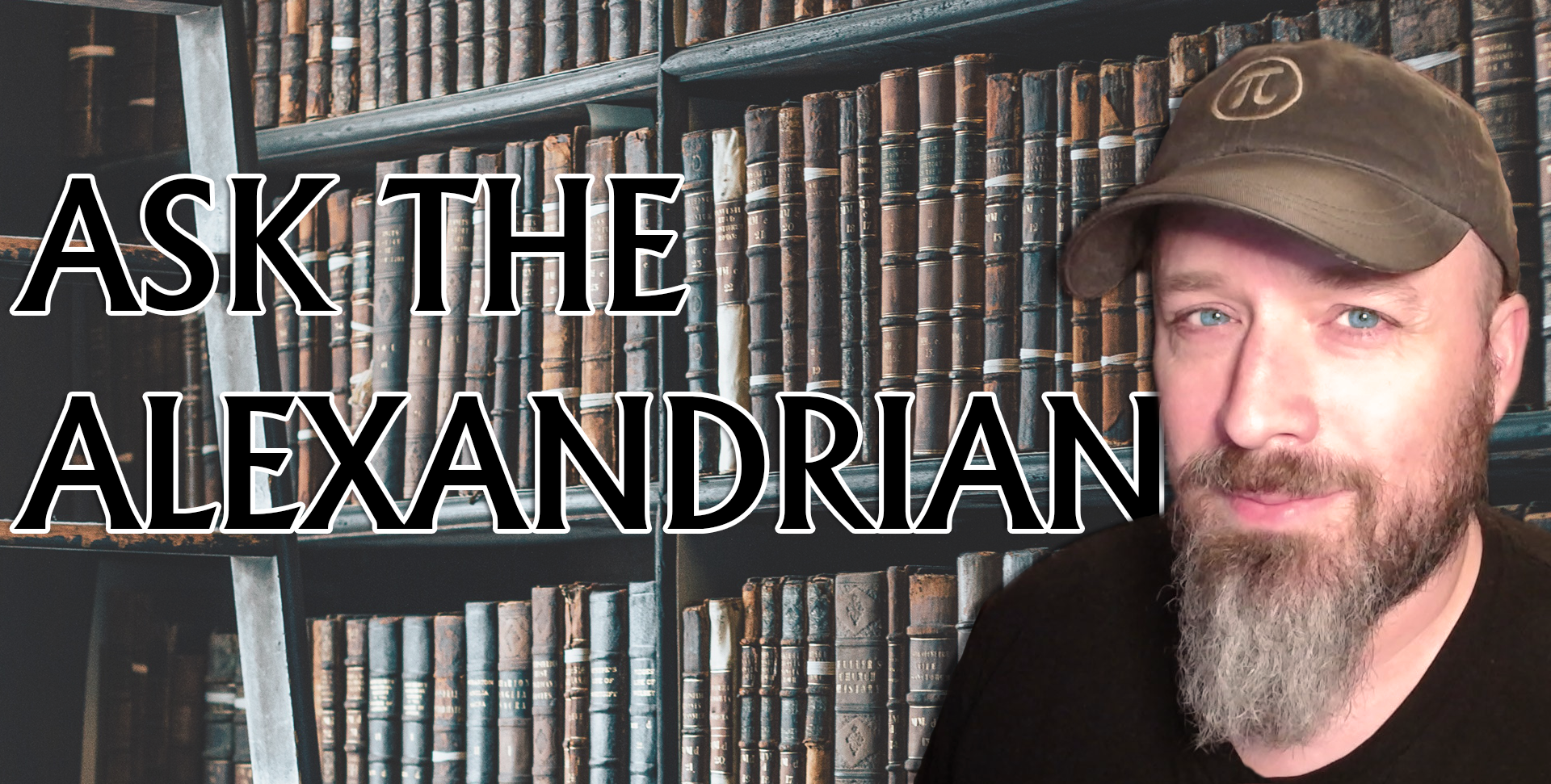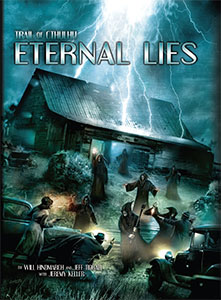 Eternal Lies is an amazing campaign written for Trail of Cthulhu by Will Hindmarch, Jeff Tidball, and Jeremy Keller.
Eternal Lies is an amazing campaign written for Trail of Cthulhu by Will Hindmarch, Jeff Tidball, and Jeremy Keller.
The basic conceit of the campaign is that a decade ago a band of occult investigators battled against the summoning of an ancient and monstrous evil… and failed. Now the PCs need to piece together what went wrong and try to salvage whatever they can. It was explicitly designed to be a spiritual successor to the Masks of Nyarlathotep and, like that classic campaign, features a freewheeling, international investigation of epic scope.
Long-time readers of the site may recall that I consider Masks of Nyarlathotep to be one of the best RPG campaigns ever published, and that it also provided the core concept for both the Three Clue Rule and Node-Based Scenario Design. Despite the incredibly high esteem in which I hold the Masks of Nyarlathotep, however, I’m of the opinion that Eternal Lies is even better.
It’s probably unsurprising, therefore, that a few months back I started prepping to run Eternal Lies. As is often the case, however, I got a trifle ambitious with my plans. The result was a large expansion (and a slight revamping) of the entire campaign, and over the next couple or three weeks I’d like to share with you the material I developed in the form of the Alexandrian Remix of Eternal Lies.
SPOILER WARNING
This should probably go without saying, but from this point forward there will be huge spoilers for Eternal Lies. Literally stuff that will spoil the entire campaign for you.
As a particular warning for players in my extended gaming network: I’m planning to run this campaign again at some point in the (probably near) future. If you’d like to be able to actually play the campaign, I’m afraid you’re going to have to tune out of my website for a little while.
DESIGN NOTES
There are several core elements which make up the remix, and I think the material will be a little clearer if I explain its structure.
First, there are LOCATION DIORAMAS. The campaign, as published, is broken up across nine distinct locations. For each of these locations I prepped a diorama which could be hung on the wall near the gaming table. The centerpiece of each diorama was a large, poster-sized map. This was accompanied by a variety of photos, drawings, period advertisements, and the like. The idea was to provide a rich, visual reference for the players.

The dioramas were also intended to be persistent and interactive. As the PCs gathered clues and other materials in each location, they could be added to the dioramas. And as the PCs moved to each new location, the dioramas from the previous locations would remain. Over the course of the campaign, the gaming area would become immersed in the 1930s through a slow, inevitable, kudzu-like growth.
Second, there are PROP PACKETS. These are, again, grouped by location. I used a handful of physical props which, in the absence of 3D printing, I’m unable to share with you, but most of the materials are paper props of various kinds.
- For newspaper articles, I printed them on sheets of 8.5” x 11” newsprint.
- Most of the photos are designed to be printed directly onto 4” x 6” photo paper.
- Larger photos are designed for 8.5” x 11” photo paper. (In some cases, multiple images are arranged so that they can be printed on a single sheet and cut out.)
- For telegrams, I found that simply printing them on yellow paper was extremely effective.
- For the record album, I have included an MP3 audio file and also a CD label that can be printed using the Neato CD labels. (The CD is obviously anachronistic, but the ability to actually take the prop and play it is pretty awesome.)
Most of these props are original (albeit often sourced from period photographs and the like). But several of the props were originally developed by and shared by others on Yog-Sothoth.com. I’m including my copies here because most of them have been altered or repurposed to fit into the rest of my campaign schema, but if you end up continuing to develop Eternal Lies material for your own tables I heartily encourage you to pop over to Yog-Sothoth and share your work with the larger community.
Third, there are my CAMPAIGN NOTES. As with the dioramas and prop packets, these are broken down by location. They serve as a quick reference for running the campaign, but obviously also contain all of the other alterations and additions I’ve made.
NODE STRUCTURE
One of my biggest goals with this remix was to enrich the node-based structure of the campaign.
As written, Eternal Lies has a fairly straight-forward structure: A short track of investigation takes you from New York to Savannah and then to a mansion in Los Angeles where you discover a book which contains clues pointing to four other locations scattered around the globe. While investigating those locations, you’ll discover additional clues which will combine to form a “final 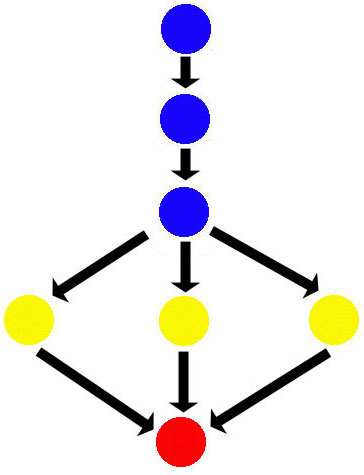 revelation” pointing you towards the conclusion of the campaign.
revelation” pointing you towards the conclusion of the campaign.
I liked the open-ended, go wherever you want structure. What I didn’t like was the book. First, it was a single point of failure: If the PCs don’t find the book, the rest of the campaign doesn’t happen. Second, it feels a little too on-the-nose in the metagame: It felt like the GM saying, “Here’s your menu for the campaign. Please make your next selection.”
I wanted something a little more organic. I wanted things to feel messy and real. I wanted to give the players a greater sense of charting their own course, instead of just picking from a menu of three options. And I wanted the choice of sequence to have a more meaningful impact on how the investigation played out.
First, I significantly decreased the importance of the book and liberally spread clues pointing to the other cult locations throughout the Los Angeles investigation. I also mixed things up by adding additional clues to both the New York and Savannah investigations: It’s now possible to go from New York directly to Los Angeles, for example. Or to follow a lead from Savannah and go directly to Bangkok.
Second, I radically increased the cross-pollination of clues between locations. For example, in the original campaign the only “access point” to Bangkok was the book in Los Angeles. In the remix campaign, investigators can be pointed towards Bangkok from Savannah, Malta, Mexico City, and Axum.
So if the investigators, for example, take the first clue they find in Los Angeles and skedaddle before completing the rest of their investigation there, everything will be just fine: Wherever they’re going, they should be able to dig up more clues to keep their investigation alive. (In a worst case scenario, of course, they might find themselves doubling back to Los Angeles.)
THE FINAL REVELATIONS
The biggest weakness in Eternal Lies are two revelations that the PCs have to make near the end of the campaign. The first of these is the revelation that the Devouring Mountain, where the ultimate villain of the campaign is located, is Mt. Kailash in Thibet. In the campaign as written, this revelation is theoretically split into three clues:
- A map in Bangkok showing that the villain is located at Mt. Kailash.
- A clue in Malta that the villain can only be reached at Mt. Kailash during a certain time of the month.
- A clue in Mexico City that reveals that Mt. Kailash is the Devouring Mountain.
I say “theoretically split” because it’s pretty obvious that once you get a map pointing you directly at the location, you can pretty much brute force the rest of the problem (which causes the entire campaign to short circuit).
To fix this, it has been recommended that the map in Bangkok is in a huge stack of papers and only becomes notable once the PCs discover the clue in Mexico City. This is unsatisfying, however, because it creates a dynamic where the penultimate conclusion of the campaign isn’t the result of the players solving a mystery, it’s just the GM telling them where to go next.
To make matters even worse, Eternal Lies then immediately repeats this mistake. At the conclusion of the events at Mt. Kailash, the GM is supposed to once again say, “Oh, yeah. Your characters now remember a piece of paper I never told you about that tells you what to do next.”
It’s as if you were playing a traditional murder mystery and, at the end of the scenario, the GM said, “Oh, yeah. Your character remembers seeing a clue I didn’t tell you about several weeks ago. Tom’s the murderer.”
To which I say: Bah! Humbug!
So as part of the Alexandrian Remix, these final two revelations have been significantly restructured.
First, the MT. KAILASH REVELATION consists of three clues:
- Sirikhan mounted unsuccessful expeditions to several locations searching for the Maw of the Mouth, including Mt. Kailash. (Clues to this effect are primarily found in Bangkok.)
- The Maw of the Mouth lies within the Devouring Mountain. (Clues to this effect are primarily found in Mexico City.)
- The Rift of the Maw opens only on the night of a New Moon beneath a clear sky. (Clues to this effect are primarily found in Malta.)
So in Bangkok the PCs will essentially gain a big list of location names, with no way to distinguish which location is the one they want. (Note that the only mountain in the list is Mt. Kailash.) In Mexico City they’ll be told that they’re looking for a mountain. And in Malta they’ll be told when they need to be there (which also explains why Savitree failed). It doesn’t matter which order they find these clues in, they won’t be able to piece the whole thing together unless they have all three.
Second, the REVELATION OF THE APOCALYPSE was trickier to solve. The method I eventually adopted was to NOT provide clues that allow the PCs to “solve” the mystery. Instead, I designed four key concepts:
- Great power requires great sacrifice.
- Echavarria’s ritual had two layers / two purposes.
- Edgar Job played a key role in Echavarria’s ritual, but no one knows what it was.
- Azathoth was the true focus of Echavarria’s interest.
And then I layered material supporting these concepts throughout the campaign. I can then pull whatever subset of material they discovered to form the final, spiteful vision sent to them at Mt. Kailash. For example: “Edgar Jobs dragging a cigarette and telling you he was Chosen by Echavarria in 1924. The summoning of the Liar From Beyond as only one part of the ritual. Montgomery Donovan sacrificing his wife because he knew it was necessary to sacrifice great things to achieve great power. What greater sacrifice could there be then a god summoned from beyond the Great Wall of Glaaki? And what greater power than the destructive gaze of Azathoth!”
The idea is that, at least thematically, the answer was in front of them the entire time (instead of being delivered from out of the blue). The actual solution to the problem has also been tweaked, so even after they get this revelation, they’ll still need to figure out what to actually do about it.
NEW LOCATIONS
Those already familiar with the campaign will also notice that there are two completely new locations in the Alexander Remix: The Severn Valley and Axum. Both of these arose through actual play, and I’ll be discussing the role they play in more detail as they actually get presented.
CHANGE OF DATE
A final significant change I made to the campaign was the date: As published, Eternal Lies begins in 1937, thirteen years after the original ritual was performed in 1924.
I suspect, however, that the campaign was originally supposed to start in 1934 and the decision to move it to 1937 was made rather late in the design process (for reasons that aren’t entirely clear to me). There are a number of subtle hints to this effect in the text, but the big one is that one section of the campaign is set during the Abyssinia Crisis, which started in 1934 and was concluded by May 1936.
Rather than try to completely rework the Ethiopia material, I decided to simply crank the clock back. My version of the campaign begins in New York on October 31st, 1934.
THE ALEXANDRIAN REMIX
1.0 Maps and Campaign Props
1.1 New York
1.2 Savannah
1.3 Los Angeles
Books of the Los Angeles Cult – UCLA Lot
Books of the Los Angeles Cult – Echavarria’s Library
2.0 Act II – Floating Scenes
2.1 Bangkok
2.2.1 Severn Valley
2.2 Ethiopia
2.2.1 Obelisk of Axum
2.3 Malta
2.4 Mexico City
2.5 Yucatan
Addendum: Airports
Addendum: Hotels
Addendum: Newspapers
You may also find my System Cheat Sheet for Trail of Cthulhu useful.

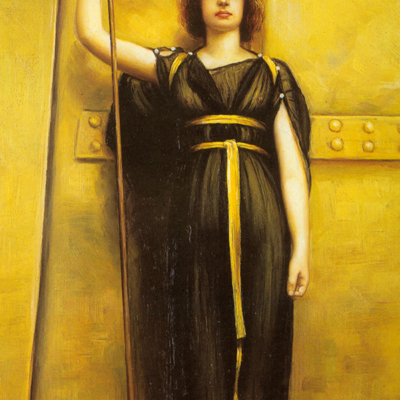
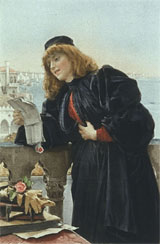 When Shakespeare sat down to write The Merchant of Venice, he was tapping into the well-established Elizabethan genre of the “Jewish Villain”. After The Merchant of Venice itself, Marlowe’s The Jew of Malta is the most famous example of the genre, but it was only one among a dozen or more plays of the same type which had been written in the 1580’s and early 1590’s.
When Shakespeare sat down to write The Merchant of Venice, he was tapping into the well-established Elizabethan genre of the “Jewish Villain”. After The Merchant of Venice itself, Marlowe’s The Jew of Malta is the most famous example of the genre, but it was only one among a dozen or more plays of the same type which had been written in the 1580’s and early 1590’s.